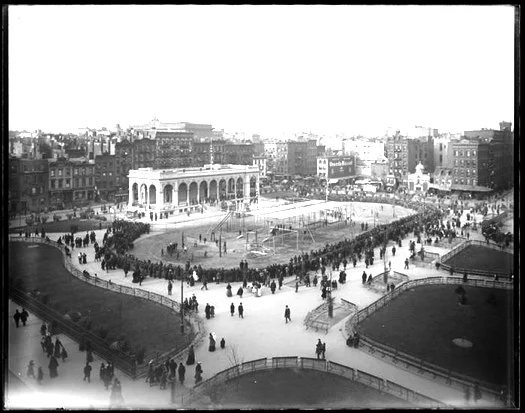As the oldest municipal playground in the U.S., Seward Park, founded in 1903, has a rich history steeped in the late 19th century immigrant neighborhood of New York City’s Lower East Side.
While the Park didn’t officially open until October 17, 1903, its precursor was the Outdoor Recreation League, formed in 1899 by social reformers Lillian Wald and Charles Stover who believed strongly that immigrant families living in squalid tenements desperately needed fresh air and exercise. The League raised funds to plant grass and trees, and to create walking paths and benches.
Prior to the League’s formation, Aguilar Free Library Society was established in 1886. The Society purchased the land for the Seward Park Public Library, adjacent to the site for the Park, and built a small building in 1890. Shortly thereafter, the German-Jewish banker, businessman and philanthropist Jacob Henry Schiff (1847-1920), erected the ornate Schiff Fountain in Rutgers Square; the fountain was moved to its present site on the Essex St. side of Seward Park in 1936.
New York City took over administration of the park in 1903. When it officially opened, published reports documented that as many as 2,000 children scrambled onto the playground. The Park included a running track, a children’s farm garden (on the present-day site of the Seward Park Garden) and was considered a model for future playground architecture. In 1904, a limestone and terra-cotta Pavilion was built with a gym, meeting rooms and the first public bathhouse to be opened in a New York City park. Rocking chairs were placed on the porch for use by mothers tending to their small children. Just five years later, in 1909, the Seward Park Library was built, replacing the Aguilar Free Library building.
In 1936, the Pavilion was demolished and later, in 1941, a new recreation building opened, known as the Park House which stands today and includes public restrooms and a community room. In 1941, the Park offered basketball courts, horseshoe pitching, shuffleboard and a paved area for roller-skating and ice skating. Fast-forward to 2001, and Seward Park underwent a redesign by the New York City Department of Parks. In 2019 the park was again redesigned (as part of the Parks Without Borders project) to its present-day status. The Landmark Seward Park Public Library was redesigned from 2002-2004.
The Park is named for William Henry Seward, the Secretary of State under Presidents Abraham Lincoln and Andrew Johnson, who is best known for his purchase of Alaska from Russia in 1867. Seward was also known for his support for immigrants, particularly the Irish, who backed him for New York State Senator in the 1830s, Governor of New York in the 1840s and United States Senator in the 1850s.
On the East Broadway side of the Park, in the newly designed garden, there is a historic reference to Seward’s connection in the form of Togo, a bronze statue of the husky that played a heroic role in delivering anti-diptheria serum to Nome, Alaska in 1925. Read Togo's story here.



